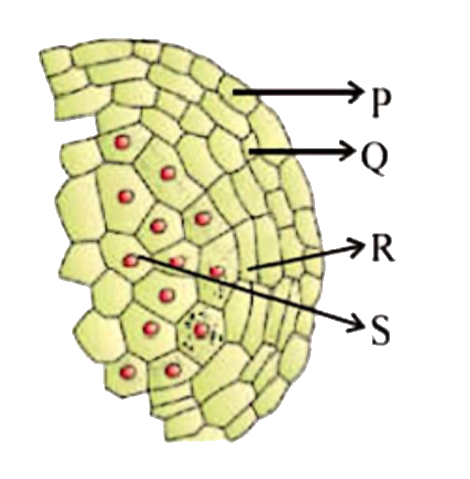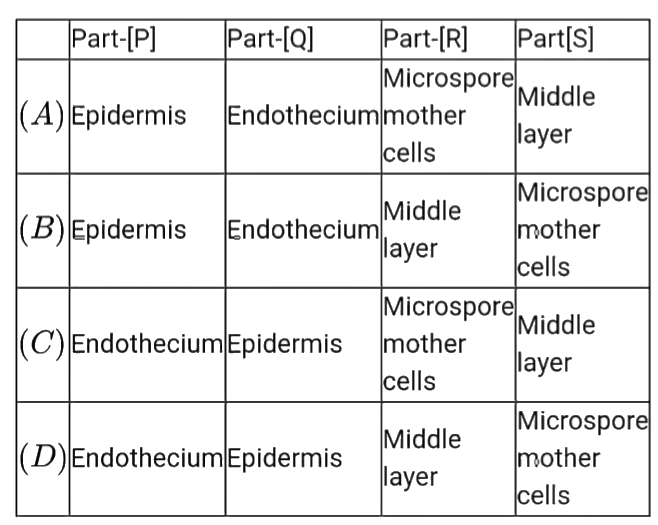The second meiotic division of ………..P …….. is unequal and results in the formation of ………. Q …….. .
Select the appropriate option for P and Q.
P-secondary spermatocytes, Q-spermatids
P-primary oocyte, Q-ovum
P-secondary oocyte, Q-polar body
P-primary spermatocytes, Q-spermatids
The correct Answer is:C
To solve the question, we need to identify what "P" and "Q" represent in the context of the second meiotic division.
1. Understanding Meiosis:
- Meiosis consists of two divisions: Meiosis I and Meiosis II. The first division is reductional, and the second division is equational. However, in certain cases, the second meiotic division can be unequal.
2. Identifying P:
- The question states that the second meiotic division is unequal. This is characteristic of oogenesis (the formation of ova in females), where the primary oocyte undergoes meiosis to form a secondary oocyte and a polar body.
- Therefore, "P" refers to the secondary oocyte, which is the product of the first meiotic division.
3. Identifying Q:
- The unequal division during the second meiotic division results in the formation of one ovum (mature egg) and one polar body.
- Thus, "Q" refers to the polar body, which is a small cell that is a byproduct of oocyte division and typically does not participate in fertilization.
4. Final Answer:
- Based on the above reasoning, we conclude that:
- P = Secondary oocyte
- Q = Polar body
Conclusion:
The correct answer is:
- P = Secondary oocyte
- Q = Polar body
---
- Meiosis consists of two divisions: Meiosis I and Meiosis II. The first division is reductional, and the second division is equational. However, in certain cases, the second meiotic division can be unequal.
- The question states that the second meiotic division is unequal. This is characteristic of oogenesis (the formation of ova in females), where the primary oocyte undergoes meiosis to form a secondary oocyte and a polar body.
- Therefore, "P" refers to the secondary oocyte, which is the product of the first meiotic division.
- The unequal division during the second meiotic division results in the formation of one ovum (mature egg) and one polar body.
- Thus, "Q" refers to the polar body, which is a small cell that is a byproduct of oocyte division and typically does not participate in fertilization.
- Based on the above reasoning, we conclude that:
- P = Secondary oocyte
- Q = Polar body
The correct answer is:
- P = Secondary oocyte
- Q = Polar body
Similar Questions
Knowledge Check
During spermatogenesis, the second maturation division results in the formation of:
A8 haploid spermatidsB2 diploid spermatidsC4 haploid spermatidsD4 haploid spermatids
After completion of second meiotic division of the secondary oocyte and result in the formation of a (A)–––– and a haploid (B)––––.
View SolutionSecond meiotic division during oogenesis is completed in
View SolutionWhat promotes completion of second meiotic division in oogenesis?
View SolutionIdentify the parts labelled P, Q, R, and S, and select the right option about them.


View SolutionHow many meiotic divisions are required during the formation of 500 zzygotes, if in males one meiotic division result in formation of four male gametes and in females one meiotic divison results in formation of one female gamete?
View SolutionFor the formation of 32 spermatide, meiotic division occurs in cells
View Solution1 meter long metallic wire is broken into two unequal parts PandQ.P part of the wire in uniformly extended into another wire R. Length of R is twice the length of P and the resistance of R is equal to that of Q. Find the ratio of the resistance P and R and also the ratio of the length PandQ
View Solution
